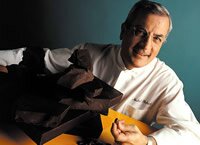Michel Richart
 Introduction
Introduction
The series The Art of Living, presented in triptych form, enables us to discover three key areas of French culture, taken in its broadest and most immediate sense.
Led by specialists in their respective fields, these lectures, including tastings, will bring new understanding to the creation of high quality products in the tradition of French savoir-faire.
The Speaker
A symbol of refinement and luxury, true chocolate is in danger of disappearing into the great abyss of “junk food.” Returning to the sources of quality having its roots in the ancient civilizations of pre-Columbian peoples, Michel Richart, world-renowned chocolatier, will evaluate the situation of this dangerous evolution. The meticulous choices of raw material, the delicate care necessary in harvesting, and the complexity of production procedures have made the production of chocolate throughout the centuries a complex art form whose outcome is pure pleasure for the senses.
Defender of the grand tradition of chocolate, Michel Richart spent his childhood with his father and his mother in the laboratory and chocolate shop established on the slopes of the Croix-Rousse in Lyon. Richart’s father passed on to him his knowledge and his know-how. He learned the art of making chocolate and became conscious of the importance of the quality of raw materials, of the generosity of recipes, and of the precise expertise required for every product. He perfected his art thanks to tastings of cooking, pastry, chocolates, and wines, all of which took place within the family.
He took over the family business in 1968 and until 1985 developed a high-end chocolaterie— highly regarded in France by all the great professionals—for which he received the “Chocolaterie Blue Ribbon” seven times.
Between 1986 and 1987, he created the concept “Design and Chocolate” and launched the “Richart Design and Chocolate” brand. In 1988, he inaugurated his boutique “Richart Design and Chocolate” at 258, Boulevard Saint-Germain in Paris.
Since the beginning, in 1988, he has opened fifteen outlets in France and abroad. In 2003, he renewed the concept by creating new chocolates and regrouping them into seven aromatic families. In the newly conceived boutiques, which are specially designed to meet the needs of this original concept, customers get to sample different flavorful notes with the help of a “chocolates organ” before proceeding to the aroma wall for the final selection.…
Michel Richart is currently developing the Chocolate and Desserts Collections, designed with the pleasure in mind that sampling affords. It goes without saying, however, that its success relies upon the enlightened attitudes and discerning taste buds of chocolate devotees who are the only real guarantee of preserving the high quality of this divine treat.
Lectures
High-quality chocolate: a long chain of excellence
Not all chocolates are born equal. Just as in wine, there exists a multitude of different chocolates. Not all chocolates bring the same pleasure when tasted. What is high-quality chocolate? How do we recognize it? What is the chain of excellence that enables its production from basic ingredients – from the cocoa bean to the finished product? The chocolate that we taste is only the last link in a long and complex alchemy to which many different players contribute: botanists, farmers, chocolatiers, candymakers. Michel Richart will center his lecture on two principal points – cocoa’s agricultural chain of excellence and the production of chocolate.
The art of tasting chocolate and selection of the correct accompanying beverage (coffee, tea, spirituous liquors, alcohols)
Consumed at the Procope, the legendary Saint-German-des-Près restaurant, coffee contributed to the rapid development of another drink: chocolate. The pleasure of discovering chocolate, the pleasure it brings to the senses, and the pleasure of a convivial coming together to share chocolate all contribute to the art of tasting chocolate warranting educational methods identical to those developed in the seventies with respect to wine-tasting. It is therefore important to know how to sample chocolate correctly in order to get the most out of the tasting experience.
As always, when considering which flavors work well together, the basic agreement requires that each product be served by another, causing neither collision nor catastrophe, at the service of a new and harmonious ensemble, a pairing that is balanced and united. As in chocolate fillings, two different principles must preside at this agreement. Whether it’s coffee, tea, or wine, the same rules apply: complementarities or opposition of gustative characteristics must therefore be sought out – the result playing with flavors (particularly with acidity), aromas (generally complementary) and body (complementary or opposing). A subtle balance must be maintained so that the savors of the chosen drink are not too pronounced.
Host this lecture - Online forms
Host this lecture - Paper forms